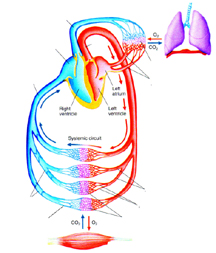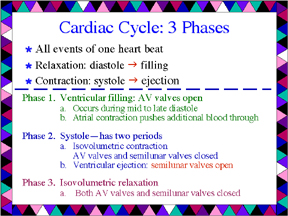|
|
Cardiovascular Physiology:
|
| ______ Tricuspid valve ______ Pulmonary veins ______ Left ventricle ______ Lungs ______ Mitral valve ______ Venules ______ Pulmonary semilunar valve ______ Pulmonary arteries ______ Veins ______ Right atrium ______ Right Ventricle ______ Capillaries ______ Aortic semilunar valve ______ Arteries ______ Inferior vena cava or superior vena cava ______ Left atrium |
 |
| The right side of the heart is associated with the pulmonary or systemic circuit. The left side of the heart is associated with the pulmonary or systemic circuit? What valves are the atrial-ventricular (AV)? What valves are referred to as semilunar? What is the cardiac cycle? Describe in PRECISE detail the cardiac cycle? See below if you need assistance. Why during systole does the aortic semilunar valve hinder blood entrance to the coronary arteries? So when then is the myocardium supplied with blood? Trace very clearly the cardiac conduction system from the SA node, AV node, AV bundle, bundle branches, and purkinje fibers. Is the SA node in the right or left atrium? What is the ability of the heart to generate it’s own electrical signal called? In actuality, when the ventricles pump, they must squeeze 1) from bottom up or 2) from top down? Describe the components of a ECG tracing including the P wave, QRS complex, and T wave. When is atrial depolarization and repolarization? When is ventricular depolarization and repolarization? Can you draw and explain this electrical event? What is normal sinus rhythm? What is sinus bradycardia? What is sinus tachycardia? The nervous system that plays a big role in influencing slower resisting heart rates is 1) the parasympathetic system or 2) the sympathetic system? What would a normal stroke volume be in ml? Is it ml per beat, per min or per hour? What is end-diastolic volume (EDV)? What is end-systolic volume (ESV)? Mathematically how can you describe SV, EDV and ESV? Heart rate is always looked at in beats per ______? What is ejection fraction? An average ejection fraction would be what percent at rest? How would you classify an ejection fraction of 70%? How would you classify an ejection fraction of 50%? What does cardiac output represent? Is it liters per beat, per min or per hour? Mathematically, if you have two of the following you can always calculate the third (EDV, ESV, SV). Make sure you can do this. For instance, if EDV is 110 ml and SV is 55 ml, what is ESV. Or if ESV is 60 and SV is 65, what is EDV? Make sure you can calculate ejection fraction. What would be considered an average ejection fraction? Make sure you can calculate cardiac output in ml/min as well as L/min. Here are some practice calculations. Make sure you can do all of these! EDV = 110, SV = 70: What is ESV and What is Ejection fraction? ESV = 80, SV = 80: What is EDV and What is Ejection fraction? EDV =120, SV = 70: What is ESV and What is Ejection fraction? If HR = 180 b/min and SV = 100 ml/b what is Q? If HR =195 b/min and SV = 115 ml/b what is Q? What are some unique characteristics and metabolic needs of red blood cells? What energy system do they use? What is exercise hyperemia? Explain what causes it. Cardiorespiratory Response to Exercise What is the anticipatory response of HR to exercise. What causes this? How does heart rate relate to VO2 during progressive increasing intensity exercise? How does heart rate respond to progressively increasing intensities of aerobic exercise? Does it plateau at maximal exertion? In class we discussed 4 factors that effect SV. What are they? Discuss/explain these factors! SV plateaus in untrained individuals at about what range of VO2max? Can stroke volume of athletes be dramatically higher than untrained individuals? How is blood redirected due to exercise? Explain what happens to systolic and diastolic blood pressures in an exercise setting. What is arterial-(mixed) venous O2 difference (a-VO2 difference)? What does it represent? Be able to calculate a resting and exercise a-vO2. For instance: Rest 20 ml O2 in 100 ml arterial blood to the cell 15 ml O2 in 100 ml venous blood leaving cell What is aV02 difference? (answer = 5 ml O2) At a submaximal intensity, doing the same amount of work, which participant will have a LOWER exercise heart rate: Trained or Untrained What is the Fick equation? |
 |
Respiratory Physiology
|
Review the oxygen delivery system as you did for cardiovascular: Know and explain the following: Pulmonary ventilation (breathing) Alveoli exchange of gases between the lungs and blood which is EXTERNAL RESPIRATION Transport of oxygen and carbon dioxide Capillary gas exchange at tissues which is INTERNAL RESPIRATION What is very different about the bronchioles in the bronchiole tree when compared to the primary bronchus, secondary bronchus, tertiary bronchus? What is the conducting zone? Do you know another name for it? What is the respiratory zone? Approximately how many alveoli are there in a healthy adult? Be able to Draw and Explain the main structures of an alveolus including the alveolar macrophage, simple squamous cells and surfactant-secreting cells. What is the respiratory membrane? Explain and/or draw Boyle's Law. How is this related to pulmonary ventilation (breathing)? Explain the mechanics of Inspiration and Expiration: What is happening to the diaphragm and external intercostal muscles? What does it mean that one process is active and the other is passive? In a deep inspiration and deep expiration, what other muscles are now involved? How would you describe the diaphragm muscle? What is a pressure gradient? What is a partial pressure? Can you calculate a pressure gradient if given two partial pressures? Let’s try. Calculate the following Pressure gradient: Atmoshere PO2 = 159 mmHg; Alverolare PO2 = 104 mmHG: Pressure gradient =___ Explain/Discuss the following special topics (this may have been covered earlier in a previous unit): Oxygen deficit, EPOC, and Redox Potential (Refer to other links on our exercise physiology page for more information on Oxygen deficit, EPOC and Redox Potential) Oxygen deficit and EPOC Link Redox Potential Link With Redox potential, to keep glycolysis moving, you want more of what? NAD+ or NADH +H+: NOTE, this may or may not be covered in this section and will be only used in a test if covered in class lecture. What is the concentration of Nitrogen, Oxygen and Carbon dioxide in atmospheric air? What law says partial pressures are proportional to their concentration? Calculate the partial pressure of Nitrogen, Oxygen and Carbon dioxide. Use standard atmospheric pressure of 760 mmHg. For help go to this link: Partial Pressure Calculation Now compute this if the atmospheric pressure was 720 mmHg. Now compute this if the atmospheric pressure was 700 mmHg. Class Remember: Dalton’s law states: Partial pressure is proportional to its concentration Gases prefer to go from a 1) higher pressure to lower pressure or, 2) lower pressure to higher pressure? Where does external respiration take place? Where does internal respiration take place? Which involves the pulmonary circuit and which involves the systemic circuit? What is 1 MET equivalent to? How much O2 (in percent) combines with hemoglobin? Where does the remainder of the oxygen dissolve? How many hemoglobin molecules on one red blood cell? Each hemoglobin can carry how many molecules of oxygen? When a hemoglobin is fully loaded it is called what? When a hemoglobin molecule is only partly loaded it is called what? The term when oxygen binds to hemoglobin is called what? (oxy-hemoglobin) If the PO2 is low, will the hemoglobin have less or more saturation? If the PO2 is high, will the hemoglobin have less or more saturation? What is the name of the graph that depicts the oxygen-hemoglobin relationship. Lets interpret the oxygen-hemoglobin dissociation curve. If the PO2 is 40 mmHG and the percent saturation of hemoglobin is 75%, how much oxygen has been consumed? Where is the oxygen going? If the PO2 is 20 mmHG and the percent saturation is 35%, how much oxygen has been consumed? At the muscle tissue, capillary PO2 is 104mmHG and the PO2 in the muscle tissue is 40mmHg. Since O2 is being consumed in the tissues, the red blood cells in the tissue capillaries do what: Unload or Load oxygen? Thus, equilibrium is reached at what PO2? Muscle tissue capillary PCO2 is 45mmHG and the PCO2 on the red blood cell is 40mmHG. Since CO2 is being produced in the tissue, the red blood cells in the tissue capillaries do what: Unload or Load CO2? Thus equilibrium is reached at what PCO2? Review again: In the pulmonary circuit, the red blood cells are loading (O2 or CO2) and unloading (O2 or CO2)? In the systemic circuit, the red blood cells are loading (O2 or CO2) and unloading (O2 or CO2) Once again, what is the name of the respiration process in the pulmonary circuit? What is the name of the respiration process in the systemic circuit? There are FOUR factors we discussed that affect O2 unloading into the tissue capillaries? Make sure you know these very specifically? For instance, is it an increase or decrease in pH that influences O2 unloading. Make sure for each factor you know whether it is an increase or decrease that influences O2 unloading. When affected by any of these factors, what happens to the oxygen-hemoglobin dissociation curve? This ‘shift’ of the curve does what to oxygen dissociation? What is the name of this shift of the oxygen-hemoglobin dissociation curve? Special Topics: Note—test items ONLY if covered in class lecture. Discuss and describe the lactate threshold. Is it the same as the ventilatory threshold? What is the difference? There are THREE factors we discussed how CO2 is transported in the blood. What are they? Practice with your Pulmonary and Systemic circuit diagram, making sure you can label the PO2 and PCO2 as blood travels through the pulmonary and systemic circuit. What is the Haldane effect? Where in the bronchial tree does asthma have its effect? Discuss the two factors that occur with asthma at this level of the bronchial tree. What is another name for exercise-induced asthma? What is the main difference in exercise-induced asthma and asthma? When doesexercise-induced asthma usually occur? |
| Top of Page | | Research Interests | | Vita | | Articles | | New Projects | | Miscellaneous | | UNM | | Home |